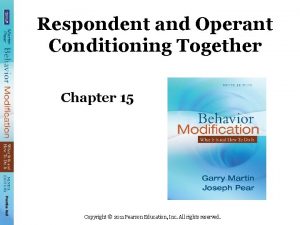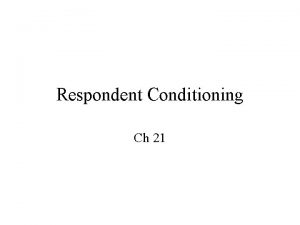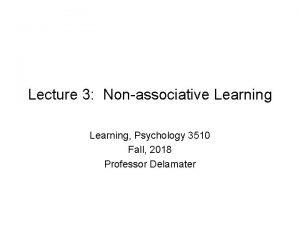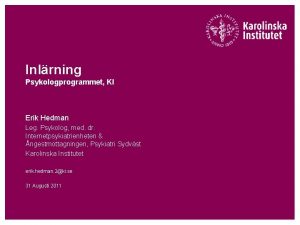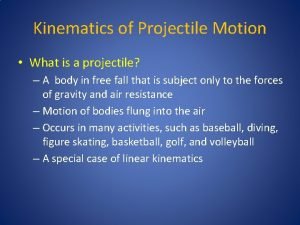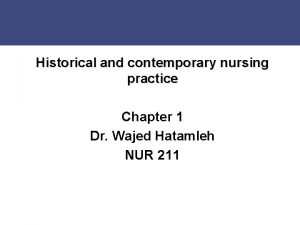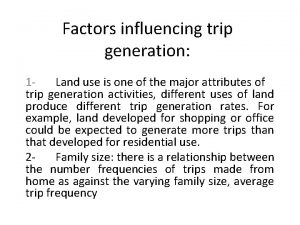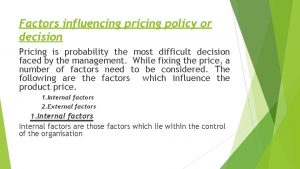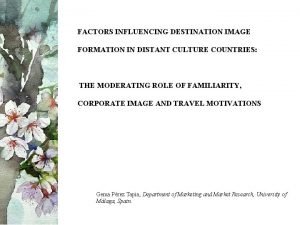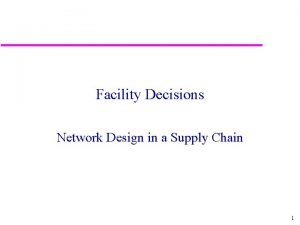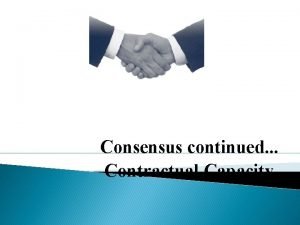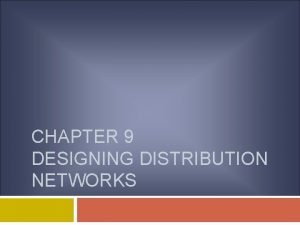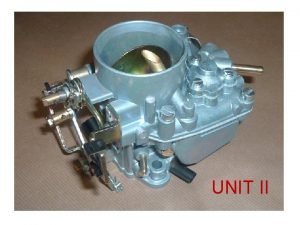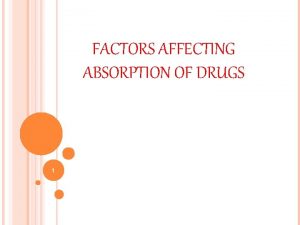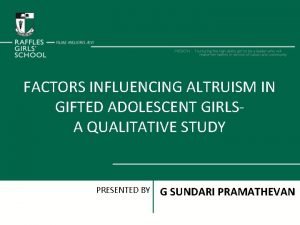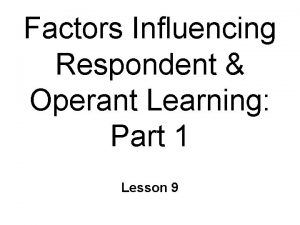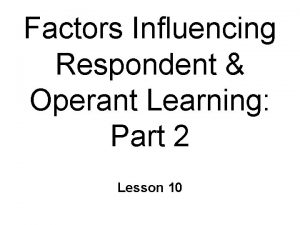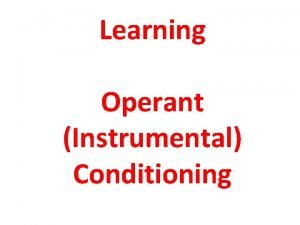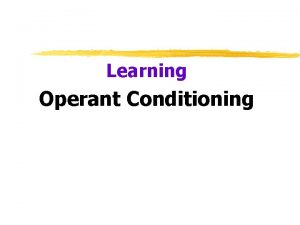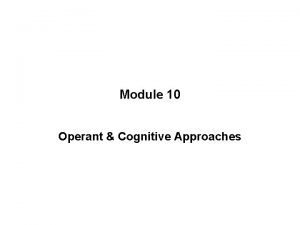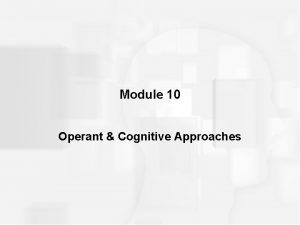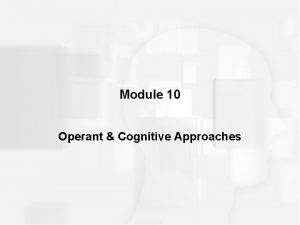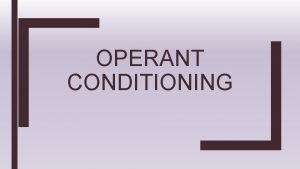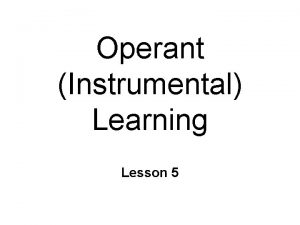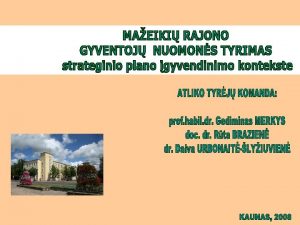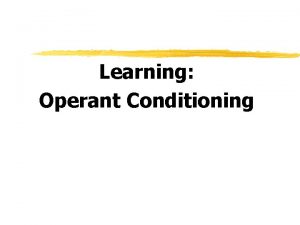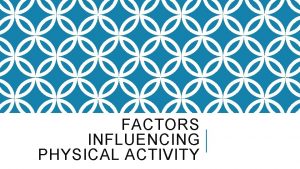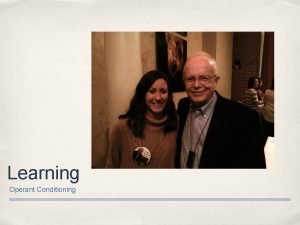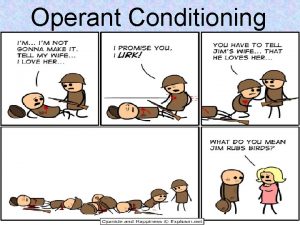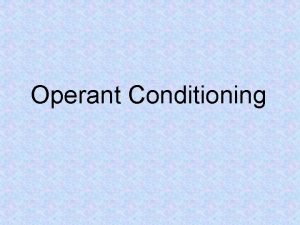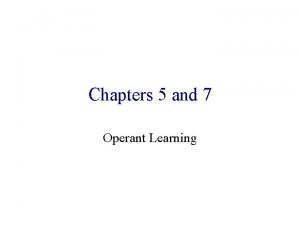Factors Influencing Respondent Operant Learning Lesson 8 Associative































- Slides: 31

Factors Influencing Respondent & Operant Learning Lesson 8

Associative Learning & Language acquisition l Interaction of nature & nurture l Respondent & operant n Respondent l Association of sounds & symbols l English: “deh” = d; “err” = r l Russian: “deh” = д; “err” = р ~ n

Respondent Learning & Language Associatе sounds/symbols with objects/actions l English: dog; woman; speak l Spanish: perro; mujer; hablar l Russian: собака; женщина, говорить n Words/ideas l Conditional stimuli l Conditional responses ~ n

Operant Learning & Language Babies start off babbling sounds l Inherited behavior n Certain sounds are reinforced l Directly by parents, etc. l Also by consequences n u n words are understood consequences Mother ~

Respondent & Operant Together SD : B CS : SR US CR UR

Respondent vs Operant Both associative n Involuntary vs voluntary n Biologically important events R l US vs S n Signals/cues D l CS vs S n Contingency R ~ l CS : US vs B S n

Factors Influencing Acquisition Frequency l # learning trials n Predictivity l contingency & probability n Contiguity l timing n Salience l Intensity / novelty ~ n

Acquisition: Frequency Gradual l usually requires many pairings l Respondent: CS : US UR l Operant: S D : B SR n Measuring the learned response l magnitude l latency / probability / frequency n Asymptote l limit to how much can be learned ~ n

Respondent Acquisition CS : US UR CR Hi Asymptote CR Strength Lo CS : US pairings

Operant Acquisition SD : B S R Hi Asymptote Bar Press Rate (B) Lo B SR Trials

Detour Learning Task

Acquisition: Detour Learning Chicks performance on detour learning task

Acquisition: Predictivity Contingency l CS+ / CSD ∆ l S / S n Probability l Usefulness of cues l Hi faster learning l Low slower learning ~ n

Contiguity: Respondent Learning n Order & Timing l Anticipate important event l strongest to weakest CR Delayed CS US CS Trace US

Contiguity: Respondent Learning Simultaneous Backward CS US

Contiguity: Respondent Learning CS-US interval n In general. . . l shorter interval more effective l longer interval less effective n Depends on response system l Fast: . 5 - 2 seconds) n ue. g. , l Slow: 2 -3 min ue. g. , l eye blink, skeletal muscle reflexes CERs, physiological responses Nausea (CTA): hours ~

Contiguity: Operant Learning Delay of Reinforcement n Immediate consequences most effective l temporal contiguity l reinforcement & punishment n longer delays: l probability of other behaviors being reinforced l instead of intended behavior ~ n

Delay of Reinforcement 20 Bar presses per minute 15 10 5 0 0 20 40 60 Delay between B and SR (sec)

Salience: Operant Learning SD / S∆ intensity l More noticeable faster learning n SR intensity l Magnitude of reinforcement l magnitude faster learning n SR value l value faster learning l Can be modified by experience ~ n

Operant: Delay vs Magnitude Delay most important factor l Small, immediate reinforcer more powerful… l Than large, delayed reward n Immediate consequences l More closely connected to situation l e. g. , hangovers as punishment ~ n

Salience: CS Intensity n CS intensity l intensity Hi Faster conditioning ~ stronger CS Asymptote CR weaker CS Lo # of CS - US pairings

Salience: CS Intensity Stimulus millieu l Always multiple potential CSs n Overshadowing l Concurrent cues l TONE/light – shock pain/fear l TONE stronger fear l light weaker fear ~ n

Salience: US Intensity n Increased intensity l Faster conditioning and… l Stronger CR possible u. Raise Asymptote

Salience: US Intensity Hi stronger US Asymptote CR weaker US Lo # of CS - US pairings

Salience & Previous Experience Surprisingness of US important l Affects rapidity & strength of learning n Novel stimuli best cues D ∆ l CS+ / CS- and S / S l Not cues for other R ~ l only occur with US/S n

Salience & Previous Experience Latent Inhibition l Slower acquisition if CS is familiar l Cues associated w/ other events R l Inhibits association w/ new US/S n Blocking effect l Tone—shock pain/fear l Tone fear l Tone/Light – shock pain/fear l Light no fear (or weak) l Redundancy ~ n

Sensory Preconditioning Conditional Stimuli paired first l no US l many times n Acquisition l one CS is paired with a US l other is not n Extinction of CS paired with US ~ n

Conditioned Taste Aversion (CTA) Exception to usual rules of conditioning l Delay can be hours l Requires only single CS-US pairing n Rats: novel food makes them sick l Will avoid that food, even if starving n Adaptive ? n Stewed tomatoes & beef jerky ~ n

Conditioned Taste Aversions Learn to avoid foods that make you sick n Eat a novel food l Taste = CS l Become sick l Avoid food n Resistant to extinction n Species specific tendencies l Mammals: Taste cues (CS) l Birds: Visual cues ~ n

Biological Preparedness Animals differentially prepared l to associate certain CSs & USs n Highly prepared l learn very quickly n Unprepared l according to general learning laws n Contraprepared l great difficulty, if at all l even w/ appropriate contingencies ~ n

Stimulus Relevance Cues relevant for biologically important event l both taste & illness for food l visual cues & painful stimuli l highly-prepared associations n Contra-prepared or unprepared for others l Taste – foot shock l Sound/light -- illness ~ n
 Non associative learning definition
Non associative learning definition Respondent vs operant behavior
Respondent vs operant behavior Respondent vs operant conditioning
Respondent vs operant conditioning Nonassociative learning
Nonassociative learning Fixed action pattern
Fixed action pattern Factors affecting learning in psychology
Factors affecting learning in psychology Respondent betingning
Respondent betingning Parental attitude meaning
Parental attitude meaning Which type of weathering
Which type of weathering Wages fund theory
Wages fund theory Physical factors influencing agriculture
Physical factors influencing agriculture Relative projection height
Relative projection height Florence nightingale definition
Florence nightingale definition Factors affecting trip generation
Factors affecting trip generation Factors influencing pricing
Factors influencing pricing Factors influencing destination image
Factors influencing destination image What are the factors affecting communication process
What are the factors affecting communication process Factors influencing maternal health
Factors influencing maternal health Local factors influencing wound healing
Local factors influencing wound healing Factors influencing faculty staff relationship
Factors influencing faculty staff relationship Facility layout types
Facility layout types Factors influencing network design decisions
Factors influencing network design decisions Physical factors influencing agriculture
Physical factors influencing agriculture Factors influencing consensus
Factors influencing consensus Types of chemical weathering
Types of chemical weathering Factors influencing distribution network
Factors influencing distribution network Developmental factors affecting oxygenation
Developmental factors affecting oxygenation The history of farming
The history of farming Factors affecting carburetion
Factors affecting carburetion Factors influencing t&d
Factors influencing t&d Factors affecting absorption of drug
Factors affecting absorption of drug Factors of altruism
Factors of altruism

